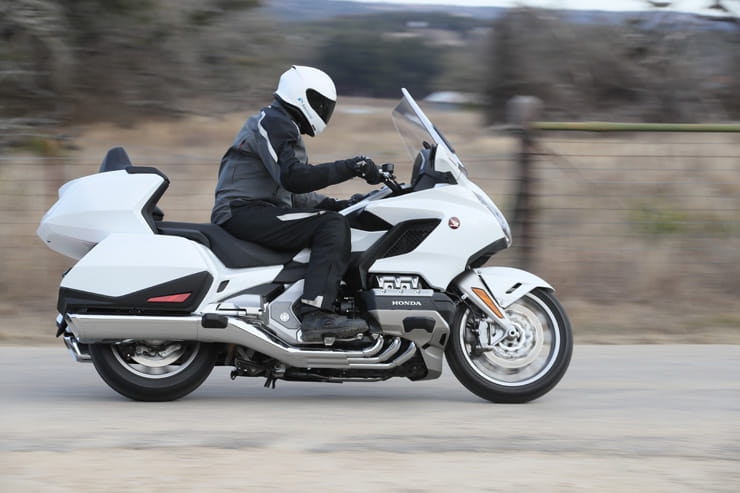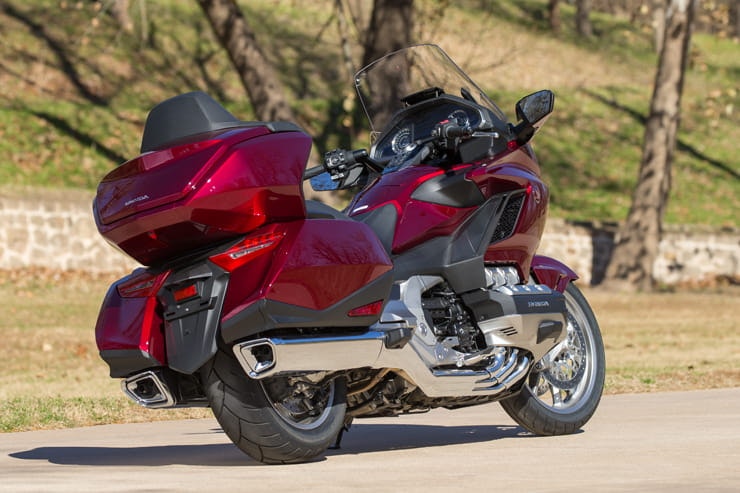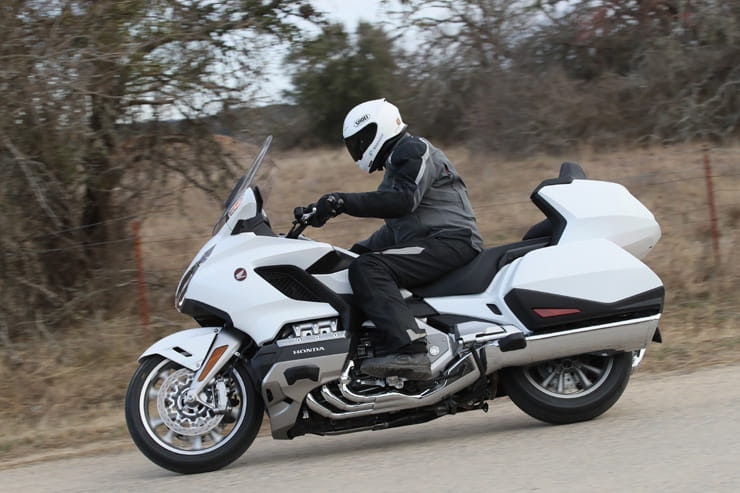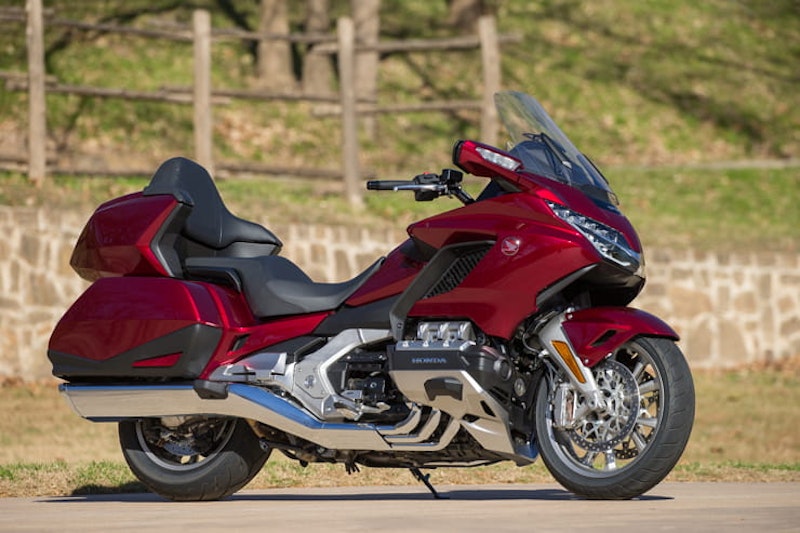Honda Gold Wing (2018) | First ride & review
By Steve Rose
BikeSocial Publisher since January 2017.
23.01.2018
17 years ago, when Honda last updated the Gold Wing a phone was something you called people on and something called ‘Friends Reunited’ was all the rage. Thankfully, it was worth the wait.
2018 Gold Wing is lighter, smaller and more powerful than the previous bike
Wednesday 10am
There are two types of motorcycle press conference. The first is where a manufacturer talks about ‘148 new components in the engine alone’, which is a code for ‘There’s no real difference, but we had to change stuff to comply with emissions regulations’.
The second is a proper world launch of a completely brand-new motorcycle, where there’s so much to say that most of the info is compressed into teeny soundbites without enough time to give the detail we all crave.
Honda’s 2018 Gold Wing launch is very definitely the latter. The presentation lasts an hour and only glosses over the changes in the new bike. Never mind the amount of new engine components, there were 90 full patents awarded to Honda in the development of the new Wing.
The aim was, according to project leader Mr Nakanishi, “To build a 21st century Gold Wing that maintained its luxury while being a more ‘rounded’ motorcycle. As useful in the city as it is on tour, built using the very latest technology available.”
The highlights of the press conference (apart from the photographer’s name actually being ‘Mr Wing’) are that the new bike is 37kg lighter than before (48kg in markets where you can buy the ‘bagger’ version minus the top box), with an all-new engine making 10 bhp more through an optional seven-speed Dual Clutch Transmission (DCT) gearbox to a 200-section rear tyre via sophisticated traction control systems. DCT’s smooth shifting makes it the most pillion friendly transmission available, making headbanging history.
All-new front suspension replaces telescopic forks with a double-wishbone, single shock set-up, attached to a stiffer, lighter, alloy frame, that allows more room for rider and pillion with class-leading audio, navigation and easy-to-use controls. All of this is wrapped up in funky bodywork and the latest LED lighting, slickly damped luggage lids and improved aerodynamics (at the expense of a few litres luggage capacity).
Any questions? They will all be answered in the next ten hours.
Wednesday 1pm
Stood by the bikes, trying to work out why 28 degrees farenheit feels so cold. The keyless fob is in the storage pouch, so a quick twist of the ignition lights up the dash. The new integrated starter motor/generator (saves 2kg) is silent in operation, but the new engine (smaller bore, longer stroke, four valve heads, single injector fuelling) sounds more purposeful than before. All the switchgear is intuitive so I’ve got heated seats and grips on full blast, selected a riding mode, found a suitably cheesy radio station and discovered that 28°F is actually -2°C by the time the Italians have finished their fags. A few hours ago, it was minus eight.
There’s not much grip and today's 300 mile ride on Texan backroads has been swapped for a 100 mile ramble on main roads from Austin to our overnight stop in Fredericksburg, with a longer ride tomorrow. The first half hour is going through the regular checklist. Every tester has one – riding position, controls, power delivery, gearchange, braking etc. The sort of stuff you need to know before the launch turns into an unofficial TT.
And the answers are…
Riding position is good. Shorter handlebars sit further from the rider, who now sits closer to the screen, but has more room. The seat has lost the lip that we’d have called ‘King and Queen’ in the old days and the bars feel less like a tiller than before. On this DCT bike, you simply press ‘D’ and twist the throttle. Riding modes are selected from the right hand switchgear. ‘Touring’ makes most sense for this road, giving a linear throttle response, soft-set suspension, moderate traction control and a gearbox that gets into top in seconds and staying there for as long as possible.
The radio stayed on till the freeway – above 60mph I can’t hear it clearly enough with my visor down, even with the screen fully raised. Acceleration is strong and the new 4-valve heads extend pulling power right into the red zone. The ride quality is superb, although the roads are pretty smooth compared to the UK and it’s hypnotic watching the steering linkage on top of the front wishbones bouncing up and down.
Sport mode stiffens the suspension, sharpens the throttle and holds onto lower gears for longer. It feels like it’s trying too hard and the higher revs when cruising create a weird oscillating noise behind the screen at 60mph which, without earplugs (cos I’m testing the screen) is really distracting.
Wednesday 3pm
We’ve been doing 80mph into a minus-five northwesterly, winter headwind for the last twenty minutes. In the distance, the Texan sun is giving way to an even colder Texan winter dusk. If it gets any colder I might have to close my visor.
Check out any line of older Wings at an owner’s rally and you’ll see dozens of different aftermarket plastic parts trying to fix the buffeting or the noise. Finally, the Gold Wing has an electrically adjustable screen. And it works. Not as effectively as the Pan European, which can be ridden visor-up at 120mph, but it’s the cold, not the watery eyes that’s holding me back today. Adjustment is via a neat toggle switch and there’s an additional pop-up flap on the dash to tailor airflow more accurately. Our party has riders from five-foot-five to six-foot-four and everyone is happy with the airflow. For many owners, that fact alone will be reason to buy one.
Approaching junctions I experiment with low speed balance – that moment when it’s all too easy to topple over on something this heavy. The balance is superb - even at a standstill I can remain feet-up for a couple of seconds. U-turns are easy and the DCT has a ‘walking’ mode that works in forward or reverse, which makes them even more confident.
This is good because as existing owners get older they want something a little easier to move around, without sacrificing that ‘Wing thing’ they love. Whether they will be happy with slightly less luggage capacity is another matter and without all the knobs and buttons, it looks more like a smartphone than a 1970s synthesiser.
Less luggage aids aero and intuitive switchgear for the 2018 Gold Wing
Thursday 9am
Early in the ride, I’m enjoying the manual gearbox version of Honda’s new Gold Wing. Just as I’m getting in the groove of a 381kg super tourer our guide rider Brad (yes, really) stops abruptly at one of those unsigned, rural American crossroads. I see his brake lights late (the new Wing’s LEDs are more subtle than the old one) and grab a handful of the all-new six piston calipers. This may not end well.
On almost any other heavyweight tourer the next thing that happens is an enormous clunk as softly sprung telescopic forks bottom out, followed by the front wheel locking, the ABS cutting-in and panicked feet-down flailing.
Today, the new Wing simply dips it’s front end in a controlled way as the brakes do their thing, the tyre grips and stays gripped even in temperatures just above freezing. We simply stop with no drama. Wow, that’s impressive.
There are lots of memorable things about Honda’s all-new GL1800, but the double wishbone front suspension is stunning. Not just because of the way it brings improved ride quality and control in corners, not just because it allows a sportier, sharper chassis and not just because it allows an ordinary rider to brake in an emergency on fresh-chilled tarmac without drama.
What really makes this suspension special is that it allows you to do pretty much all of the above at the same time because it effectively separates steering, braking and suspension.
Sorry for banging on about it... you’re probably waiting to hear about the gadgets and gizmos and peripheral Gold Wing fluff that turns this bike into a sideshow for many motorcyclists. I know that testing a Gold Wing is different, but this front end turns it into a credible motorcycle that doesn’t need excuses.
Having said that, it still needs some time to settle in and work out the right combination of gadgets to tailor the bike to suit. On the DCT GL1800 the gear settings are linked to the four riding modes. In ‘Tour’, ‘Rain’ and ‘Econ’ it changes up through the gears quickly, settling into seventh and holding onto it for longer. In ‘Sport’ it holds onto lower gears for longer before changing up and combines with the stiffer suspension settings and more direct throttle response to give a much sportier ride.
Or you can use it as a manual gearchange which lets you choose the riding mode that suits you but you change the ratios via paddles on the left-hand switchgear which are quicker and slicker than most quickshifters. The biggest benefit of DCT on a Wing is the smoothness of the gearchange. Getting a slap from your pillion’s helmet is a thing of the past even if you take it two-up drag racing (probably).
Wishbone front suspension takes all the drama out of emergency stops on a 381kg bike
Thursday 2pm
As we wind on the miles, the bike becomes familiar. The low, wide seat makes climbing aboard easier than adventure bikes and (thanks to the 37kg weight loss and shorter handlebars) it’s much easier to lift off the stand than the old one.
This part of the ride is on winding (but not too twisty) backroads. It’s a good test of the chassis and the engine’s flexibility. I’m using sport mode but with the gearchange set to manual. This gives me the sporty suspension settings and sharper throttle, but I can stay in higher gears for longer and use the torque to pull through corners. Switching on the move is simple using the controls on the right handlebar. The simple centre-console and even simpler left-hand switchgear allow you to control almost anything on the move.
That ‘anything’ includes audio, sat nav, Bluetooth (including Apple Car Play), settings on the bike and trip info displayed. Even in winter gloves the switches and buttons are simple and accurate to use.
We didn’t do enough miles to measure the extra MPG in economy mode, but on a moderately paced couple of days we were averaging 48mpg, which works out at roughly 230 miles to a tank and is bloody good for a bike this big on a press launch.
Thursday 3pm
Today has been more fun. Traffic-free backroads, gently winding, easy, but challenging enough to keep you working. It’s only later when I see some of the video footage that I realise how bumpy the roads were. The front suspension is working very hard to keep me comfy, while never putting a wheel out of line in the corners. Somehow I luck out and get the manual bike for most of the last hour. If you were single and sporty, but wanted a Wing, this is the one you’d buy. Going back to a six-speed gearbox, controlled by my brain with no regard for pillion comfort, the Gold Wing turns into a surprisingly cheeky sporting tourer. The word that keeps coming back is ‘responsive’. It goes like I want it to, steers like I want it to and holds a line in bumpy corners too. A bit like borrowing your boss’s Jaguar and thrashing down your favourite B-road only to discover it can boogie in the bends. We’re almost back at the hotel now and it’s a great way to end the ride
Thursday 4pm
Honda thoughtfully gave us a 2017 Gold Wing for comparison. After the new bike it feels big, heavy, clumsy at low speed and cramped. The engine feels woolly and unresponsive, suspension is vague and less controlled while the screen is either noisy and windy (in the low position) or buffeting when fully up.
The 2018 Gold Wing is a stunning bike and for the first time in a long time, it has the balls to back up the baubles. If you see one in your mirrors this summer, be polite because there’s a good chance that the next thing you’ll see are its tailpipes.
Engine
All new, with four valves per cylinder, revised airflow and ride by wire throttle, which between them make the bottom end power smoother, midrange stronger and increases the top end by 10bhp too. This is the most powerful Gold Wing ever and the most economical as well. So much so that the fuel capacity is reduced by four litres, but the tank range remains the same.
Gearbox
Seven speed dual clutch transmission is a semi-auto gearbox with six close ratios and a cruising overdrive, plus built-in ‘walking speed function for forward or reverse crawling. The manual bike has a six-speed gearbox with reverse function similar to the old five speed 2017 bike.
Chassis
All new alloy beam frame has just seven welds (the old one had twenty) which gives increased rigidity for less weight. New swing arm and drive shaft assembly is lighter than before.
Suspension and brakes
Linked braking system with new six-piston front calipers and ABS. Double wishbone front suspension has two linkages that give progressive bump control and separate steering from suspension and braking forces. Suspension has electronic preload and damping adjustment.
Riding modes
Tour, economy, rain and sport modes. Tour has linear throttle response (50 per cent twist gets 50 per cent throttle), moderate traction control (TC) assistance and comfy suspension. Sport has a sharper throttle with more go per twist and stiffer suspension. Economy has less go per twist and same suspension and TC as touring. Rain mode has an even softer throttle, more TC and touring suspension settings.
Audio, navigation etc
DAB radio plus Bluetooth and USB connectivity. Four speakers and Apple Car Play compatibility too. Control is either from centre console or left-hand switchgear.
Navigation is bespoke Honda. Not touch screen, it’s controlled from centre module or switchgear.
Electronic cruise control, heated grips and seat on both models and tyre pressure monitors are also standard.
Luggage/screen/central locking
50 litre top box and 30 litre panniers have damping on lids and solenoid button operation. One ‘smart key’ fob allows keyless operation including fuel filler, perimeter security and central locking.
Honda Gold Wing 2018 Specification
Price: £26,679 (manual), £29,699 (DCT)
Engine: 1833cc liquid-cooled flat-six
Power (claimed): 125bhp @ 5500rpm
Torque (claimed): 125lb-ft @4700rpm
Transmission: Six speed manual or seven-speed DCT. Shaft final drive
Frame: Alloy beam frame
Suspension: (F) Double wishbone forks with preload adjustment
(R): monoshock adjustable for preload and rebound damping (electronic preload adjustment on DCT
Brakes: (F) Twin 320mm discs, six-piston calipers; (R) 316mm disc, twin-piston caliper
Tyres: (F) 130/70 R18; (R) 200/55/R16
Wheelbase: 1694mm
Seat height: 744mm
dry weight: 381kg
Fuel capacity: 21 litres (4.6 gallons)
Top speed: 125mph (est)
Fuel consumption: 48mpg
Insurance: Click here for a competitive quote



